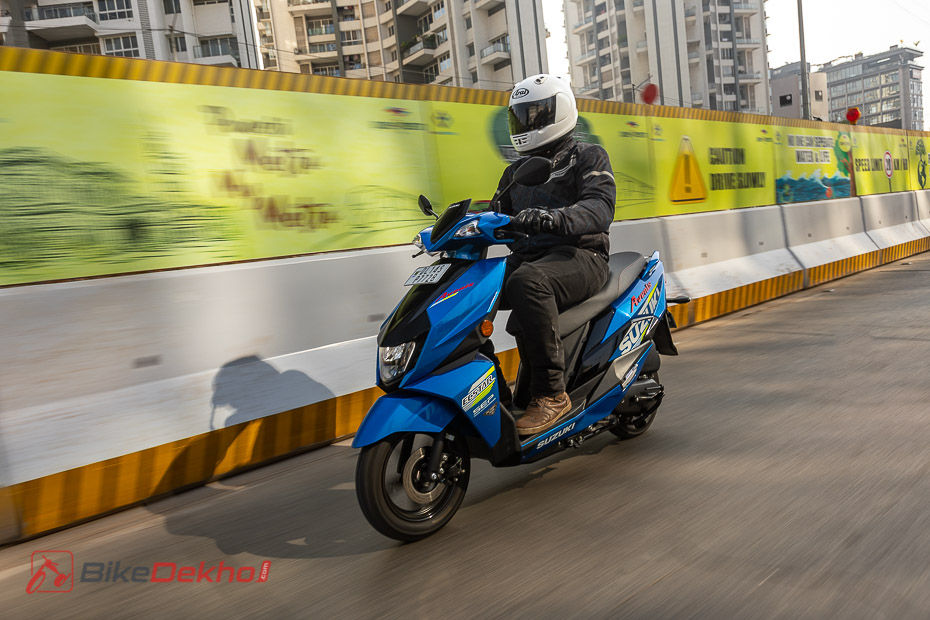Suzuki Avenis First Ride Review - Likes and Dislikes
Modified On Feb 18, 2022 01:22 PM By Sudipto Chaudhury for Suzuki Avenis
- 1257 Views
- Write a comment
Does Suzuki’s answer to the TVS NTorq 125 have its own identity, or is it just a hastily made replica?

The scooters in Suzuki’s 125cc arsenal – the Access 125 and Burgman Street 125 – were not slow by any chance, but they still sported comparatively conservative exteriors. With that in mind, they launched the Avenis in November last year, positioned as the sporty offering, and aimed squarely at the TVS NTorq 125.
And now that we were finally able to ride the Avenis, we compiled a list of things we liked and a few things we didn’t.
What We Liked

Refinement
First of all, Suzuki’s 125cc engine by itself was hardly vibey. So that means you’ll be quite well-contained from the vibes when piloting the Avenis, too. The engine turns over with just a touch of the starter button, and settles immediately into a sedate thrum, which stays almost unchanged at city speeds, the forward motion complemented by only a low hum (instead of the raspy note heard from the scooter it’s benchmarked against).
This seems like the SOP, so to speak, even when out on the open road, where the mirrors start showing some distortion only at the kind of high speeds the majority of us won’t be doing on city roads anyway. And finally, on one of our test runs where we encountered a long enough road, we were able to wring out the Avenis to an indicated 103kmph, and even here we felt only minor vibes from the footboard.

Handling
Now that we’ve established the Suzuki Avenis is one smooth operator (forgive the pun), we now move onto how easy it is to operate, whether at a standstill, or on the move. Due to its lightness, it becomes almost hilariously easy to place it in choc-a-bloc parkings, or to flick it through slow-moving rush hour traffic. Apart from the low kerb weight, the 12-/10-inch wheel setup also improves its agility.

Performance
Another place where the Avenis’ lightness pays dividends is in its acceleration figures. And as is clearly available, the Avenis’ alacrity at getting off the line makes it perhaps the quickest 125cc scooter we have tested.
Besides, due to its overall calm demeanour, the Avenis doesn’t actually feel fast. There’s no drama to its movements. And this sense of effortless performance, without an overpowering exhaust note or vibes, is something which will no doubt hold it in good stead on those weekend breakfast rides.

Convenience
The front apron of the Avenis gets cubby holes on either side: the one on the left has both a lid (not lockable), as well a USB port, while the one on the right seems big enough to fit a one-litre water bottle.
Besides, the Avenis Ride Connect edition which we tested sported a Bluetooth compatible digital cluster (lifted straight off the Access and Burgman) boasting features such as call/SMS alerts and turn-by-turn navigation, along with an overspeeding alert.
What we disliked

Braking
The Avenis gets a disc up front and a drum at the rear, and gets a CBS (combined braking system) setup as standard. And though the braking seems optimal, you’ll still be left guessing as to the braking distance on offer.

Price
The Suzuki Avenis retails at Rs 86,700 for the Ride Connect edition, with the Race edition (sporting the Ecstar Suzuki MotoGP colours) can be had at a Rs 300 premium. This not only makes it about Rs 2000 costlier than the Access’ Bluetooth-compatible variant, but just Rs 400 cheaper than range-topping Race XP variant of the TVS Ntorq 125, which has time and again held its own against bigger, and faster scooters.
Now, though Suzuki has promised a more affordable ‘Standard’ variant of the Avenis, we don’t expect that to come in too much below the Race Connect variant’s asking price, and that is something that just might discourage price-conscious buyers.

Styling
Before we get to the verdict, we have to address the elephant in the room. The Avenis looks more than just ‘inspired’ by the NTorq; in fact, bits like the fuel filler cap, pillion grab rails, placement of the headlight and indicators, and even the design of the rear fascia seems almost like a copy-paste job.
And to add insult to injury, the attempt at replication hasn’t been done all that well either. So though it gets a sharp headlight, the small-ish DRL seems like an afterthought. Ditto for the taillights (yes, there are two of them) which are placed inversely with reference to the NTorq’s rear design. So while the NTorq gets a centrally placed LED taillight with two ‘after-burners’, on the Avenis the central area is a black panel, flanked by the dual triangular LED taillights.

Verdict
Rather than centering its very identity into being a ‘sporty’ offering, the Avenis serves as a logical mid-point between out-and-out performance, and conventional usability. It’ll take you to the office on the weekday, and to your favourite weekend chai-maggi spot with equal ease. Yes, it has its faults, but nothing (except for the derivative looks) that can come across as a deal-breaker in our opinion.
So if you’re on the lookout for a daily commuter that has no qualms at taking the long way home through the twisties, the Suzuki Avenis fits the bill to the T.
